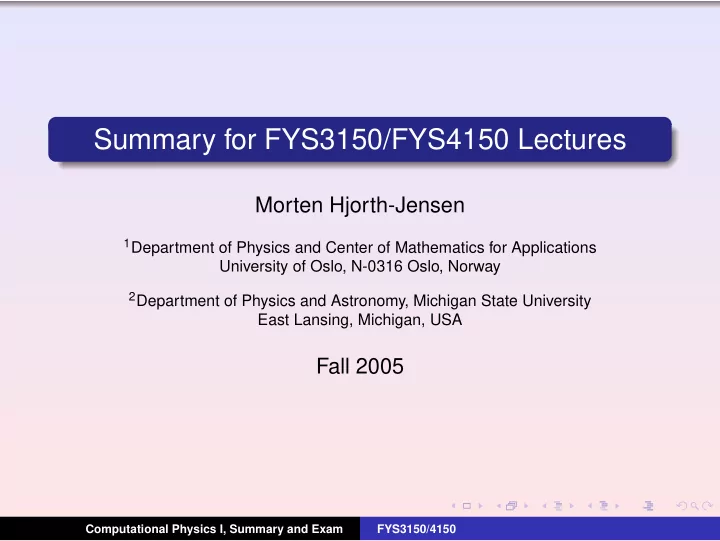

Summary for FYS3150/FYS4150 Lectures Morten Hjorth-Jensen 1 Department of Physics and Center of Mathematics for Applications University of Oslo, N-0316 Oslo, Norway 2 Department of Physics and Astronomy, Michigan State University East Lansing, Michigan, USA Fall 2005 Computational Physics I, Summary and Exam FYS3150/4150
Week 48, 28 November - 2 December End of PDE part, Summary and exam discussion Monday: Repetition from last week and discussion of Project 6 End of partial differential equations part, discussion of how to solve Schr¨ odinger’s equation. Fast Fourier transforms, Danielson-Lanczos’ algorithm. Wednesday: Summary and exam discussions. Project 6 ends this week. Computational Physics I, Summary and Exam FYS3150/4150
Exam FYS3150/4150, place FV329, Lab Place and duration 12-14/12 and 19-20/12. duration: 45 min ca 20-25 min for discussion of the project, your presentation, reproduction of results, test runs etc 20-25 min for questions from one of the five topics listed below. Final list mailed to all. Changes must be communicated to katrine.langvad@fys.uio.no. Computational Physics I, Summary and Exam FYS3150/4150
Exam FYS3150/4150 How to prepare your Talk You can use slides, ps, pdf, ppt etc files (projector and slide projector at room FV329) 10 mins (3-5 slides) for your presentation, rest of 10-15 mins questions and test of code from classfronter You should discuss (briefly) The mathematical model and the physics Your algorithm and how you implemented it, with perhaps a selected calculation How you dealt with eventual comments and your corrections of these Any improvement you can think of And: we welcome your critiscism to the project. Computational Physics I, Summary and Exam FYS3150/4150
Exam FYS3150/4150 Topics Go to http://www.uio.no/studier/emner/matnat/fys/FYS3150/h05/, and click on syllabus. Linear algebra and eigenvalue problems. (Lecture notes chapters 4 and 12 and project 1) Numerical integration, standard methods and Monte Carlo methods (Lecture notes chapters 7 and 8, project 2) Monte Carlo methods in physics (Lecture notes chapters 9 and 10, projects 3-4) Ordinary differential equations (Lecture notes chapters 13 and 14, project 5) Partial differential equations (Lecture notes chapter 15 and textbook chapter 30, project 6) Computational Physics I, Summary and Exam FYS3150/4150
Exam FYS3150/4150 Linear algebra and eigenvalue problems Know Gaussian elimination and LU decomposition How to solve linear equations How to obtain the inverse and the determinant of a real symmetric matrix Cholesky decomposition Householder’s tridiagonalization technique and finding eigenvalues based on this Jacobi’s method for finding eigenvalues Computational Physics I, Summary and Exam FYS3150/4150
Exam FYS3150/4150 Numerical integration, standard methods and Monte Carlo methods Trapezoidal and Simpson’s rules Gaussian quadrature, emphasis on Legendre polynomials, but you need to know about other polynomials as well. Brute force Monte Carlo integration Random numbers (simplest algo, ran0) and probability distribution functions, expectation values Improved Monte Carlo integration and importance sampling. Computational Physics I, Summary and Exam FYS3150/4150
Exam FYS3150/4150 Monte Carlo methods in physics Random walks and Markov chains and relation with diffusion equation Metropolis algorithm, detailed balance and ergodicity Ising model and Potts model Expectation values such as the energy or the variance in statistical physics based on Boltzmann distribution Simulation of phase transitions, first and second order phase transitions. Computational Physics I, Summary and Exam FYS3150/4150
Exam FYS3150/4150 Ordinary differential equations Euler’s method and improved Euler’s method, truncation errors Runge Kutta methods, 2nd and 4th order, truncation errors How to implement a second-order differential equation, both linear and non-linear. How to make your equations dimensionless. Boundary value problems, shooting and matching method (chap 14). Computational Physics I, Summary and Exam FYS3150/4150
Exam FYS3150/4150 Partial differential equations Set up diffusion, Poisson and wave equations up to 2 spatial dimensions and time Set up the mathematical model and algorithms for these equations, with boundary and initial conditions. Explicit, implicit and Crank-Nicolson schemes, and how to solve them. Remember that they result in triangular matrices. How to compute the Laplacian in Poisson’s equation. How to solve the wave equation in one and two dimensions. How to solve Schr¨ odinger’s equation as a PDE, see Landau and Paez chapter 30. Computational Physics I, Summary and Exam FYS3150/4150
Other courses in Computational Science at UiO Bachelor/Master/PhD Courses INF-MAT3350/4350 Numerical linear algebra MAT-INF3300/3310/4300/4310, PDEs and Sobolev spaces I and II INF-MAT3360/4360 PDEs INF5620/5630/5640 Numerical methods for PDEs, finite element method MEK4550 Finite element in solid state mechanics FYS4410 Computational physics II (Parallelization (MPI), object orientation, classical statistical physics, simulation of phase transitions and quantum mechanical systems with many interacting particles) AST5340 Numerical Simulation, Methods in numerical simulation in hydrodynamics and plasma physics applied to astrophysical problems Computational Physics I, Summary and Exam FYS3150/4150
Master and PhD Topics in Computational Physics See links under messagges at the web page of the course, both are in Norwegian however. Computational Physics I, Summary and Exam FYS3150/4150
Moralism... . . . and it is feared that the French public, always impatient to come to a conclusion, eager to know the connections between general principles and the immediate questions that have aroused their passions, may be disheartened because they will be unable to move on at once. That is a disadvantage I am powerless to overcome, unless it be by forewarning and forearming those readers who zealously seek the truth. There is no royal road to science, and only those who do not dread the fatiguing climb of its steep paths have a chance of gaining its luminous summits. Karl Marx, preface to the french edition of Capital (Progress Publishers, Moscow, 1954). Computational Physics I, Summary and Exam FYS3150/4150
AND, GOOD LUCK TO YOU ALL! Computational Physics I, Summary and Exam FYS3150/4150
Recommend
More recommend